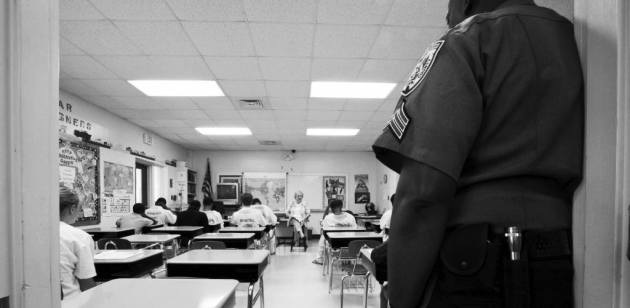
Policy Background:
Towards the end of the 1990’s, local law enforcement began building up a police presence within K-12 public schools, largely in response to school shootings that had gained national attention (e.g., Columbine). These officers’ primary responsibilities were to protect the school from active shooters and external threats – two outliers when considering typical day-to-day happenings within the school setting.
And yet, the law enforcement presence in schools has been expanding for more than a decade. However, many officers have not been given adequate training to manage a predominantly youth-filled setting. The training that peace officers are required to receive is largely geared towards protecting the public on the streets, where they are more likely to encounter law-breaking adults who are fully developed, both physically and neurologically. This disconnect in education has led to several incidents involving mismanaging youth and, in extreme instances, has resulted in youth suffering physical injury from officers.
Texas policy-makers should equip school district peace officers and school resource officers with the appropriate training to properly interact with youth. This training should include learning objectives in the following areas: child and adolescent development, positive behavioral interventions and supports, de-escalation techniques, the mental and behavioral needs of children with disabilities or special needs, mental health crisis interventions, and cultural competency.
Key Facts:
- In 1978, only one percent of Texas schools reported having police present; now, most Texas schools report police presence from a local law enforcement agency or from the school district’s own police department.[1]
- According to Texas Appleseed, which has comprehensively examined school-based issues, “police officers in some Texas schools are resorting to ‘use of force’ measures more commonly associated with fighting street crime—pepper spray, Tasers and trained canines—when a schoolyard fight breaks out or when students are misbehaving in a cafeteria or at a school event. The intent is to keep schools and students safe, but there can be unintended consequences to disciplining public school students in a way that introduces them to the justice system or exposes them to policing techniques more commonly used with adults.”[2]
Relevant Bills:
- Bill Number: HB 2220 (Coleman)
Bill Caption: Relating to mental health first aid training for school district employees and school resource officers.
Hearing Notice: House Public Education Committee, Notice of Public Hearing on April 21, 2015
- Bill Number: HB 2279 (Walle)
Bill Caption: Relating to child and adolescent interaction education and training for certain peace and reserve law enforcement officers.
TCJE Materials: Fact Sheet
Hearing Notice: House Emerging Issues In Texas Law Enforcement, Select Committee, Notice of Public Hearing on March 26, 2015
TCJE Action: Card in support
- Bill Number: HB 2684 (authors: Giddings, Walle | sponsor: Whitmire)
Bill Caption: Relating to the creation of a model training curriculum and to the required training for school district peace officers and school resource officers.
TCJE Materials: Fact Sheet
House Hearing Notice: House Juvenile Justice & Family Issues Committee, Notice of Public Hearing on April 22, 2015
Archived House Hearing Video: House Juvenile Justice & Family Issues Committee, 04/22/15 Video [TCJE testimony begins at 01:30:07]
Senate Hearing Notice: Senate Criminal Justice Committee, Notice of Public Hearing on May 22, 2015
TCJE Senate Action: Card in support
Outcome: Effective immediately (6/20/15)
- Bill Number: HB 3317 (Sanford)
Bill Caption: Relating to continuing education requirements regarding autism awareness for peace officers.
Hearing Notice: House Emerging Issues In Texas Law Enforcement, Select Committee, Notice of Public Hearing on March 26, 2015
- Bill Number: SB 133 (author: Schwertner | sponsor: Coleman)
Bill Caption: Relating to mental health first aid training for school district employees and school resource officers.
Hearing Notice: Senate Health & Human Services Committee, Notice of Public Hearing on February 11, 2015
TCJE Action: Card in support
Outcome: Effective immediately (6/17/15)
- Bill Number: SB 1037 (Rodríguez)
Bill Caption: Relating to law enforcement training programs and policies on using appropriate nonlethal force and nonviolent restraint; changing the education requirements for licensure as a peace officer.
[1] Texas Appleseed, Texas’ School-to-Prison Pipeline: Ticketing, Arrest & Use of Force in Schools, December 2010, pp. 1-3; http://www.texasappleseed.net/images/stories/reports/Ticketing_Booklet_web.pdf
[2] Ibid, p. 2.
